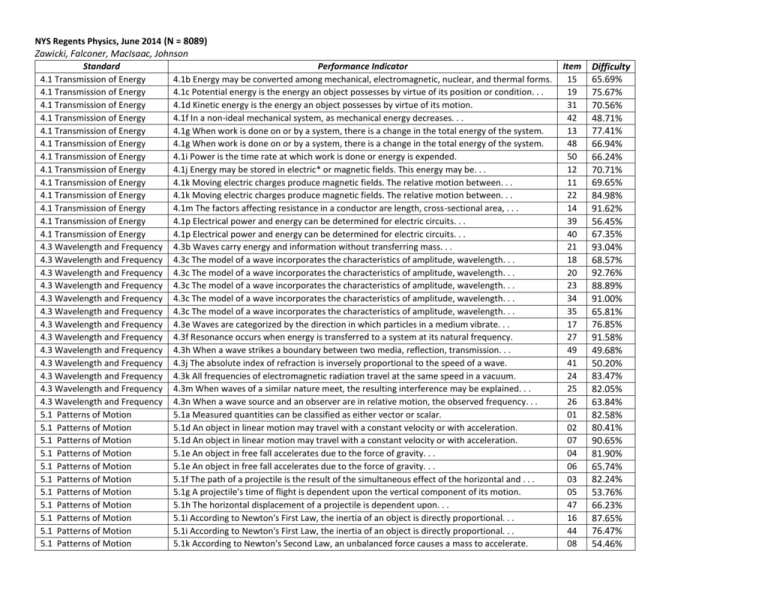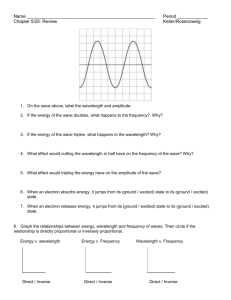NYS Regents Physics Data Handouts
advertisement

NYS Regents Physics, June 2014 (N = 8089) Zawicki, Falconer, MacIsaac, Johnson Standard 4.1 Transmission of Energy 4.1 Transmission of Energy 4.1 Transmission of Energy 4.1 Transmission of Energy 4.1 Transmission of Energy 4.1 Transmission of Energy 4.1 Transmission of Energy 4.1 Transmission of Energy 4.1 Transmission of Energy 4.1 Transmission of Energy 4.1 Transmission of Energy 4.1 Transmission of Energy 4.1 Transmission of Energy 4.3 Wavelength and Frequency 4.3 Wavelength and Frequency 4.3 Wavelength and Frequency 4.3 Wavelength and Frequency 4.3 Wavelength and Frequency 4.3 Wavelength and Frequency 4.3 Wavelength and Frequency 4.3 Wavelength and Frequency 4.3 Wavelength and Frequency 4.3 Wavelength and Frequency 4.3 Wavelength and Frequency 4.3 Wavelength and Frequency 4.3 Wavelength and Frequency 5.1 Patterns of Motion 5.1 Patterns of Motion 5.1 Patterns of Motion 5.1 Patterns of Motion 5.1 Patterns of Motion 5.1 Patterns of Motion 5.1 Patterns of Motion 5.1 Patterns of Motion 5.1 Patterns of Motion 5.1 Patterns of Motion 5.1 Patterns of Motion Performance Indicator 4.1b Energy may be converted among mechanical, electromagnetic, nuclear, and thermal forms. 4.1c Potential energy is the energy an object possesses by virtue of its position or condition. . . 4.1d Kinetic energy is the energy an object possesses by virtue of its motion. 4.1f In a non-ideal mechanical system, as mechanical energy decreases. . . 4.1g When work is done on or by a system, there is a change in the total energy of the system. 4.1g When work is done on or by a system, there is a change in the total energy of the system. 4.1i Power is the time rate at which work is done or energy is expended. 4.1j Energy may be stored in electric* or magnetic fields. This energy may be. . . 4.1k Moving electric charges produce magnetic fields. The relative motion between. . . 4.1k Moving electric charges produce magnetic fields. The relative motion between. . . 4.1m The factors affecting resistance in a conductor are length, cross-sectional area, . . . 4.1p Electrical power and energy can be determined for electric circuits. . . 4.1p Electrical power and energy can be determined for electric circuits. . . 4.3b Waves carry energy and information without transferring mass. . . 4.3c The model of a wave incorporates the characteristics of amplitude, wavelength. . . 4.3c The model of a wave incorporates the characteristics of amplitude, wavelength. . . 4.3c The model of a wave incorporates the characteristics of amplitude, wavelength. . . 4.3c The model of a wave incorporates the characteristics of amplitude, wavelength. . . 4.3c The model of a wave incorporates the characteristics of amplitude, wavelength. . . 4.3e Waves are categorized by the direction in which particles in a medium vibrate. . . 4.3f Resonance occurs when energy is transferred to a system at its natural frequency. 4.3h When a wave strikes a boundary between two media, reflection, transmission. . . 4.3j The absolute index of refraction is inversely proportional to the speed of a wave. 4.3k All frequencies of electromagnetic radiation travel at the same speed in a vacuum. 4.3m When waves of a similar nature meet, the resulting interference may be explained. . . 4.3n When a wave source and an observer are in relative motion, the observed frequency. . . 5.1a Measured quantities can be classified as either vector or scalar. 5.1d An object in linear motion may travel with a constant velocity or with acceleration. 5.1d An object in linear motion may travel with a constant velocity or with acceleration. 5.1e An object in free fall accelerates due to the force of gravity. . . 5.1e An object in free fall accelerates due to the force of gravity. . . 5.1f The path of a projectile is the result of the simultaneous effect of the horizontal and . . . 5.1g A projectile's time of flight is dependent upon the vertical component of its motion. 5.1h The horizontal displacement of a projectile is dependent upon. . . 5.1i According to Newton's First Law, the inertia of an object is directly proportional. . . 5.1i According to Newton's First Law, the inertia of an object is directly proportional. . . 5.1k According to Newton's Second Law, an unbalanced force causes a mass to accelerate. Item 15 19 31 42 13 48 50 12 11 22 14 39 40 21 18 20 23 34 35 17 27 49 41 24 25 26 01 02 07 04 06 03 05 47 16 44 08 Difficulty 65.69% 75.67% 70.56% 48.71% 77.41% 66.94% 66.24% 70.71% 69.65% 84.98% 91.62% 56.45% 67.35% 93.04% 68.57% 92.76% 88.89% 91.00% 65.81% 76.85% 91.58% 49.68% 50.20% 83.47% 82.05% 63.84% 82.58% 80.41% 90.65% 81.90% 65.74% 82.24% 53.76% 66.23% 87.65% 76.47% 54.46% Standard Performance Indicator 5.1 Patterns of Motion 5.1 Patterns of Motion 5.1 Patterns of Motion 5.1 Patterns of Motion 5.1 Patterns of Motion 5.1 Patterns of Motion 5.3 Energy Relationships 5.3 Energy Relationships 5.3 Energy Relationships 5.3 Energy Relationships 5.3 Energy Relationships 5.3 Energy Relationships Standard 5.1n Centripetal force is the net force which produces centripetal acceleration. . . 5.1n Centripetal force is the net force which produces centripetal acceleration. . . 5.1p The impulse imparted to an object causes a change in its momentum 5.1p The impulse imparted to an object causes a change in its momentum 5.1t Gravitational forces are only attractive, whereas electrical and magnetic forces can. . . 5.1u The inverse square law applies to electrical and gravitational fields. . . 5.3b Charge is quantized on two levels. On the atomic level. . . 5.3c On the atomic level, energy is emitted or absorbed in discrete packets called photons. 5.3d The energy of a photon is proportional to its frequency. 5.3g The Standard Model of Particle Physics has evolved. . . 5.3g The Standard Model of Particle Physics has evolved. . . 5.3j The fundamental source of all energy in the universe is the conversion of mass into energy. I3 The grouping of magnitudes of size, time, frequency, and pressures or other units of measurement. Item 38 45 09 10 32 33 37 43 46 28 29 30 36 Difficulty 73.66% 85.52% 62.22% 54.36% 78.23% 54.33% 58.61% 64.52% 68.69% 75.03% 78.02% 61.08% 56.36%








